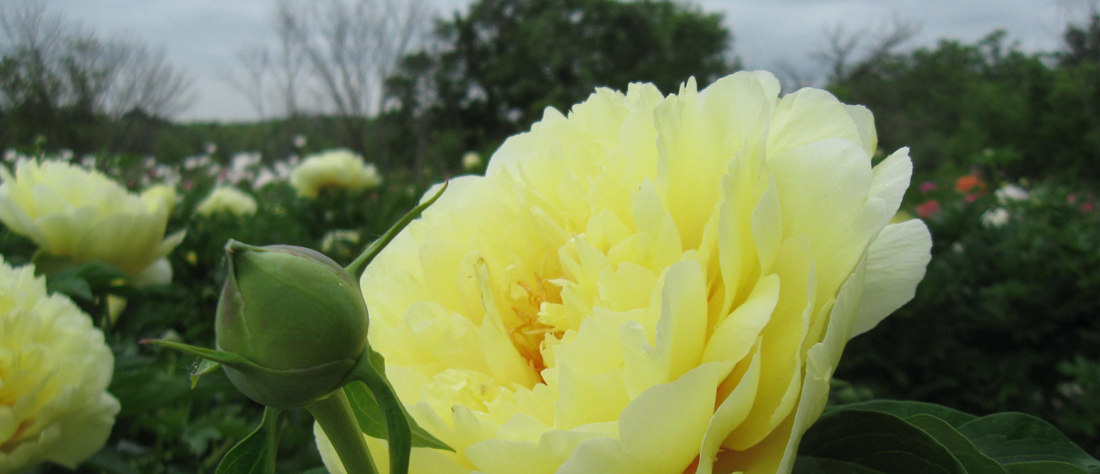Looking out at a couple of our peony fields today reminded me of what was and will be a sea of color in a few months. Though the redosier dogwoods upfront add a hint of color, it is still apparent that the winter ‘white’ is still the main color scheme this time of the season. Perhaps not as much white as our gardening friends in the mid-Atlantic and soon to be north easterners, but it is still ‘white’. This time of year provides many ‘what ifs’ in our gardening minds. So much so that I have been thinking over the years about how ‘we’ can improve our home gardens. From my previous posts on how ‘we’ prepare our soil on a large scale to grow our bare-root peonies, how can ‘we’ as home gardeners prepare our soil for peonies? Growing peonies that are chemical free is my passion! Might I perplex you a bit with this post and perhaps cause you to question ‘how to grow peonies’?
Since we are preparing our propagating fields in advance, how might that encourage you to prepare your growing sites in advance? Does adding chemically produced 10-10-10 or whatever flavor of instant fertilizer to our growing site cause peonies to grow faster? Even Milorganite, does that produce peonies faster? Case in point, in our growing fields that were prepared a year or two in advance saw significant increase in growth versus peonies that were planted around our home using our peony planting tips and chemical free peony starter fertilizer. Very interesting! We all want our bare-root peonies to grow as fast as they can, right? So I submit to you, how can peonies grow faster when their growing site nutrients and micro-nutrients have not been amended into the soil? The answer is they can’t! Soil amending, as we have seen and experienced in our growing fields, takes one to two years for nutrients to amend into the soil. Are we on to something here? The answer is definitely yes! As I mentioned above, my passion is to grow peonies without chemicals, period, but you now know my passion is also to grow peonies that are vigorous. Chemically produced fertilizers DO NOT amend the nutrients and micro-nutrients of the soil!
The waiting game! Some gardeners, including me at first, bought and planted potted peonies thinking the instant spring color was amazing! Well little did I realize that in another area of our home garden some of Roger Anderson’s intersectional hybrid peonies were planted as bare-root peonies in the fall. Oh the joy of having instant blooms of potted peonies that first year in our new home were replaced in the second and third year of oh where oh where did the potted peonies blooms go? The bare-root peonies had more blooms and vigor in the second and third year than the instant first year blooms of the potted peonies. Bare-root peonies acclimated to our growing site faster than potted peonies. Why? Potted peonies took an extra year to acclimate to their new growing site versus their comfy greenhouse led beginning. Amassed with every conceivable chemicals to help them ‘look good’ when first planted. Once the potted peonies realized they had to grow on their own, their life and vigor was set back knowing their comfy life was replaced with real world growing conditions.
Alas my conclusion, by preparing our growing site in advance allows the dormant bare-root peonies planted in the fall to taste the nutrients and micro-nutrients when they come out of dormancy in the spring! Geez you say, now I have to rethink my growing site years in advance? Well yes if you are like me! I would do the following this spring: 1) Plan where you intend to plant your 2017 bare-root peonies in the fall, yes 2017 fall peonies. 2) In the spring of 2016, excavate a 2′ wide by 2′ deep hole. 3) Put two shovel scoops of composted cow manure and one cup of Milorganite into the bottom of the hole and replace the excavated dirt. 4) Water in the dirt slowly. 5) Cut a 30″ circle of professional grade landscape fabric and staple it to your site location. 6) In the fall of 2016, take off the landscape fabric and excavate the same 2′ wide but now 1′ deep hole. 7) Put one shovel scoop of composted cow manure and one cup of Milorganite into the bottom of the hole and replace the excavated dirt. 8) Water in the dirt slowly. 9) Replace the landscape fabric and staple to your site location. 10) In the spring of 2017, take off the landscape fabric and excavate the same 2′ wide but now 6″ deep hole. 11) Put 1/2 shovel scoop of composted cow manure and 1/2 cup of Milorganite into the bottom of the hole and replace the excavated dirt. 12) Water in slowly. 13) Replace the landscape fabric and staple to your site location. 14) in the fall of 2017, plant your bare-root peonies as described in our planting tips but DO NOT ADD any composted cow manure and Milorganite! This now allows you to grow your peonies like we do in the fields! Yes it takes time, but remember what I said in the second paragraph above!
Ok for those of you who want to plan your site locations for the fall of 2016, here is a shorter version with a few less steps but the results will still help you! 1) In the spring of 2016, excavate a 2′ wide by 2′ deep hole. 2) Put two shovel scoops of composted cow manure and one cup of milorganite into the bottom of the hole and replace the dirt. 3) Water the dirt slowly. 4) Cut a 30″ circle of professional grade landscape fabric and staple it to your site location. 5) In the fall of 2016, plant your bare-root peonies as described in our planting tips and DO ADD additional composted cow manure and milorganite as described.
Perplexing? YES! How to grow peonies? YES! TIme consuming? YES! Good for bare-root peonies? YES! Worth it? YES! Time to change dear gardening friends how we all can grow vigorous, chemical free peonies!

